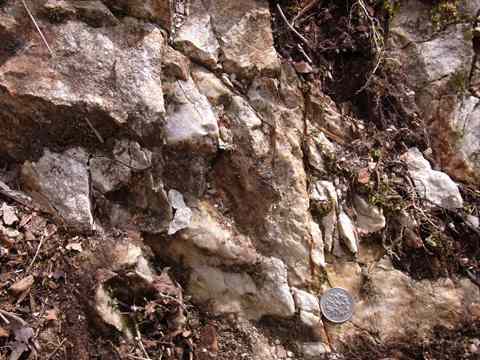Honzawa Mine
Magi, Otsuki city, Yamanashi pref., Japan
Occurrence
Au-Bi-Te-bearing low temperature hydrothermal deposit at the boundary between the late Miocene (10 Ma) Tokuwa Granite and the middle Eocene (45 Ma) Gongenyama Unit of the Sagamiko Group, a member of the Shimanto accretionary complex. Granite at this locality is the S-type (Ilmenite-series) margin of the I-type (Magnetite-series) Tokuwa Granite. The S-type (Ilmenite-series) margin was formed by reduction reation of granite magma with surrounding pelitic rocks. The Gongenyama Unit at this locality has been subjected to Albite-Epidote-hornfels contact metamorphism. Ages of sedimentary rocks were determined by radiolarians, and granite age by K-Ar radiometric dating of biotite and whole rock.

Au-bearing quartz vein in shale of the Gongenyama Unit subjected to contact metamorphism by granite. The light gray part at the upper left is metamorphosed shale. The scale coin is on the milky white quartz vein. Au-Bi-Te minerals are in this quartz vein.
Reported Minerals
- Gold
- Sulphur
- Bismuth
- Joséite(Joseite)
- Bismuthinite
- Pyrite
- Arsenopyrite
- Ilmenite
- Bismutite
- Scorodite
- Chabazite
Mineral Assemblages
- Quartz(Gangue) - Joséite(Joseite) - Gold - Bismuthinite - Bismutite
- Quartz(Gangue) - Pyrite
- Quartz(Gangue) - Arsenopyrite - Scorodite
- Granite(Host) - Chabazite
Produced metal(1942-1943)
- Gold ore: 16 tons
History
- 1942: Began to mine at the open pit.
- 1943: Closed.
Localities
- Honzawa Mine (Granite)
- Hara Mine (Granite)
- Koshu Mine (Granite)
Related Occurrences
- Pneumatolytic
- Xenothermal
- Hydrothermal (High-T)
- Hydrothermal (Moderately high-T)
- Hydrothermal (Moderate-T)
- Hydrothermal (Moderately low-T)
- Hydrothermal (Low-T)
- Hydrothermal (Au-Ag)
- Hydrothermal (Au-Bi-Te)
- Porphyry type
- Alpine Fissure
- Hydrothermal (Hot Spring)
- Hydrothermal (Fault)